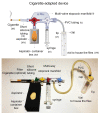A low-cost Portable Device to Deliver Smoke, Volatile or Vaporized Substances to Drosophila melanogaster, Useful for Research and/or Educational Assays
- PMID: 35005089
- PMCID: PMC8678554
- DOI: 10.21769/BioProtoc.4244
A low-cost Portable Device to Deliver Smoke, Volatile or Vaporized Substances to Drosophila melanogaster, Useful for Research and/or Educational Assays
Abstract
Drosophila melanogaster has been used to test drugs of abuse, substances with potential benefits for medical purposes, as well as contaminants and hazardous volatile compounds. This model has also been used for the characterization of behavioral changes, physiopathological consequences, and subcellular mechanisms of the use of cocaine, methamphetamines, ethanol, nicotine, cannabinoids, toluene, and other airborne volatile organic compounds. When testing these substances, routes of administration are important to define. Admixing the test compounds with water or food is one suitable option in many cases, but the inhalation route is especially suitable when the administration of one or more volatile compounds is desired. One advantage of the administration of substances via the inhalation route is its rapid exchange and distribution throughout the cuticle and the tracheal system. In addition, this route allows treating a large group of individuals simultaneously. Moreover, the inhalation route is frequently used to administer different drugs to humans. A good model system shares physiology and molecular pathways with humans, and D. melanogaster possesses almost 75% homologous genes associated with human diseases. Methodologies to deliver the abovementioned substances usually include customized devices. Herein, we focus on the development of a low-cost customized device useful to deliver smoke or vaporizable compounds to D. melanogaster. This approach might be applied for acute or chronic exposure to vaporized substances. In particular, our device was utilized for testing cigarette smoke and vaporized cannabis extract on cardiac performance of adult individuals during chronic treatment. We are describing how to set up this low-cost portable device, useful for research and/or educational assays, taking advantage of the amenability of D. melanogaster to test different compounds in relatively short periods, and especially including a large number of individuals at the same time. Graphic abstract: Custom-made device useful for inhalation pathway assays in Drosophila melanogaster.
Keywords: Adult flies; Cannabis; Custom-made device; Drosophila melanogaster; Inhalation; Smoke; Vaporized substances.
Copyright © 2021 The Authors; exclusive licensee Bio-protocol LLC.
Conflict of interest statement
Competing interestsThe authors declare no competing financial and non-financial interests.
Figures






References
-
- Bainton R. J., Tsai L. T., Singh C. M., Moore M. S., Neckameyer W. S. and Heberlein U.(2000). Dopamine modulates acute responses to cocaine, nicotine and ethanol in Drosophila . Curr Biol 10(4): 187-194. - PubMed
-
- Broderick K. E., Potluri P., Zhuang S., Scheffler I. E., Sharma V. S., Pilz R. B. and Boss G. R.(2006). Cyanide detoxification by the cobalamin precursor cobinamide. Exp Biol Med(Maywood) 231(5): 641-649. - PubMed
LinkOut - more resources
Full Text Sources
Molecular Biology Databases

